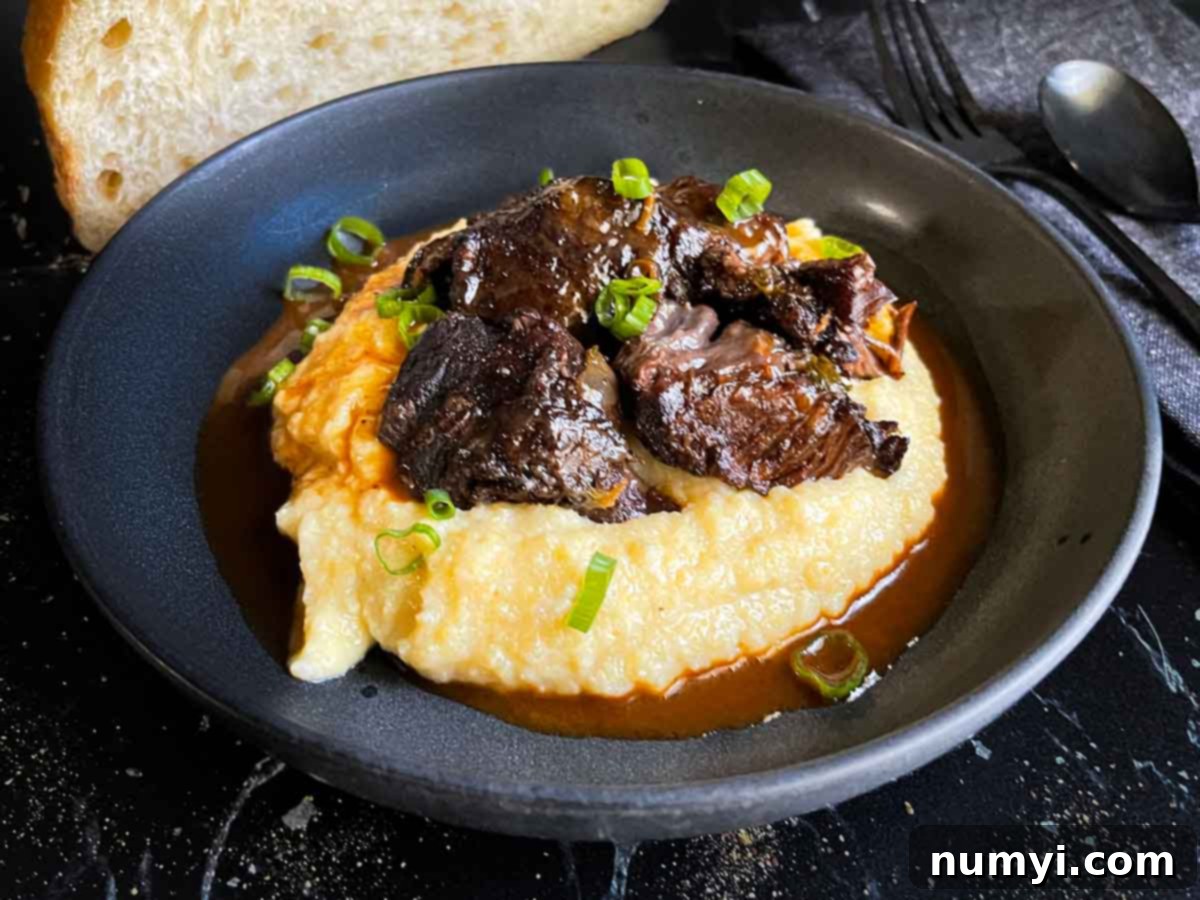The Ultimate Guide to Perfectly Braised Beef Cheeks: A Tender, Flavorful, and Unforgettable Slow-Cooked Masterpiece
Beef cheeks are an often-overlooked cut, yet they possess an incredible culinary magic. What might seem like an humble, inexpensive piece of beef can be transformed through patient, slow cooking into a dish of exquisite tenderness and profound flavor. This article will guide you through creating a braised beef cheek recipe that promises a truly melt-in-your-mouth experience, elevating a simple cut to a gourmet delight.
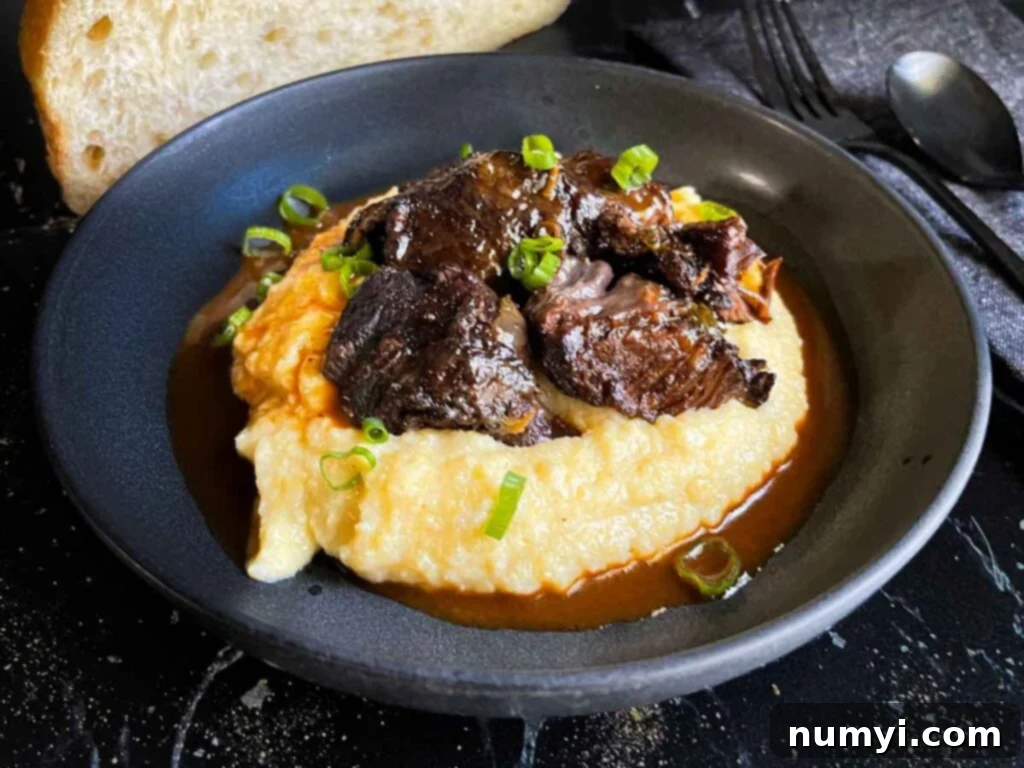
Why You Will Absolutely Love This Braised Beef Cheeks Recipe
There are countless reasons to fall in love with braised beef cheeks. Firstly, their inherent qualities are simply exceptional. With rich marbling that promises deep, savory notes and a texture that, once cooked, literally melts in your mouth, these cuts are a true delight. When prepared perfectly, a culinary transformation occurs, turning these often-overlooked pieces into a dish that epitomizes ultimate comfort and rustic elegance.
Beyond their incredible taste, beef cheeks are a hidden treasure for food lovers on a budget. Unlike many premium beef cuts that command high prices, beef cheeks offer an economical alternative without sacrificing an ounce of flavor or quality. They represent an incredible value, allowing you to create a luxurious meal without breaking the bank.
Furthermore, the unique nature of beef cheeks makes them ideal for braising. Their tough, sinewy structure, which might deter some, is precisely what makes them perfect for a slow, gentle cooking process. This prolonged exposure to moist heat breaks down the connective tissues, rendering the meat incredibly tender and succulent. The longer these tasty pieces simmer, the more the flavors meld and deepen, resulting in a complex and satisfying gravy that coats every bite.
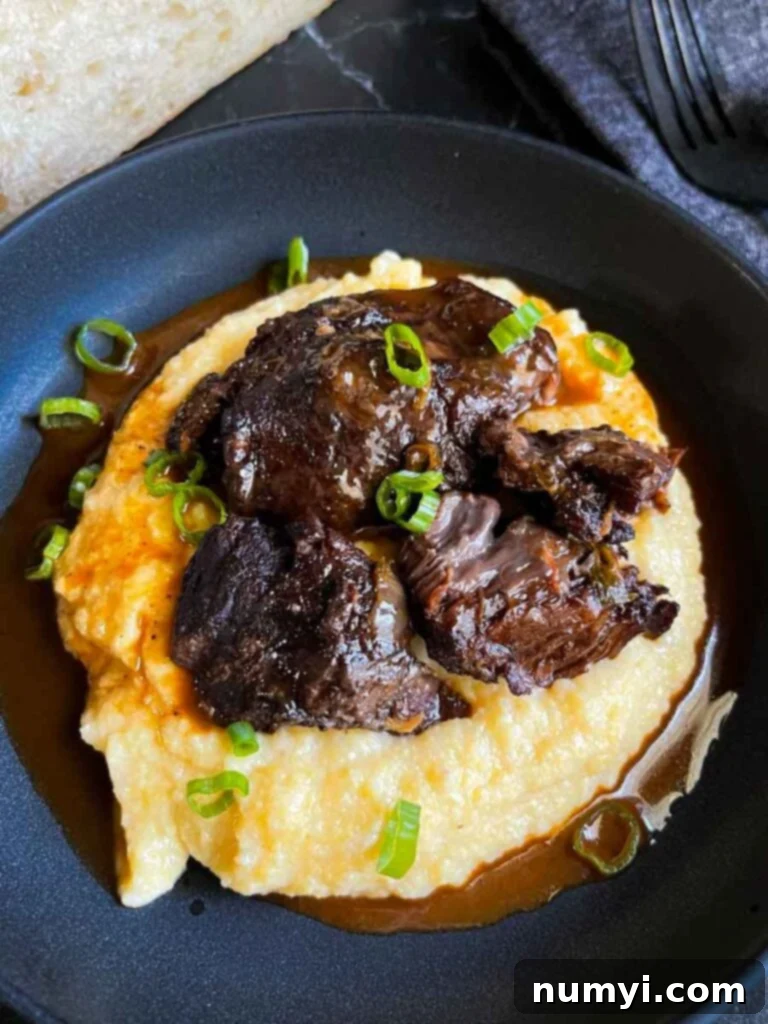
Even with relatively simple and affordable ingredients, slow-cooked beef cheeks can be transformed into a culinary masterpiece. Their humble origins belie the sublime perfection they achieve, making them a testament to the power of traditional cooking techniques.
We highly recommend serving these delectable braised beef cheeks with a side of amazing creamy polenta, as shown in the pictures. The rich, smooth texture of polenta perfectly complements the tender beef and luscious gravy. However, this versatile dish pairs beautifully with a variety of other sides, including easy mashed potatoes, decadent potatoes au gratin, a comforting basmati rice risotto, or a low-carb loaded cauliflower mash. Each option offers a unique way to enhance this already incredible meal.
Essential Ingredients for Braised Beef Cheeks
While beef cheeks might not be a staple at every local grocery store, they are becoming increasingly popular and can often be found at wholesale clubs like Sam’s Club and Costco. Your best bet for this specialty cut is often a local butcher shop, where you can inquire about its availability. Apart from the beef cheeks themselves, all other ingredients required for this robust and flavorful dish are typically readily available at any supermarket.
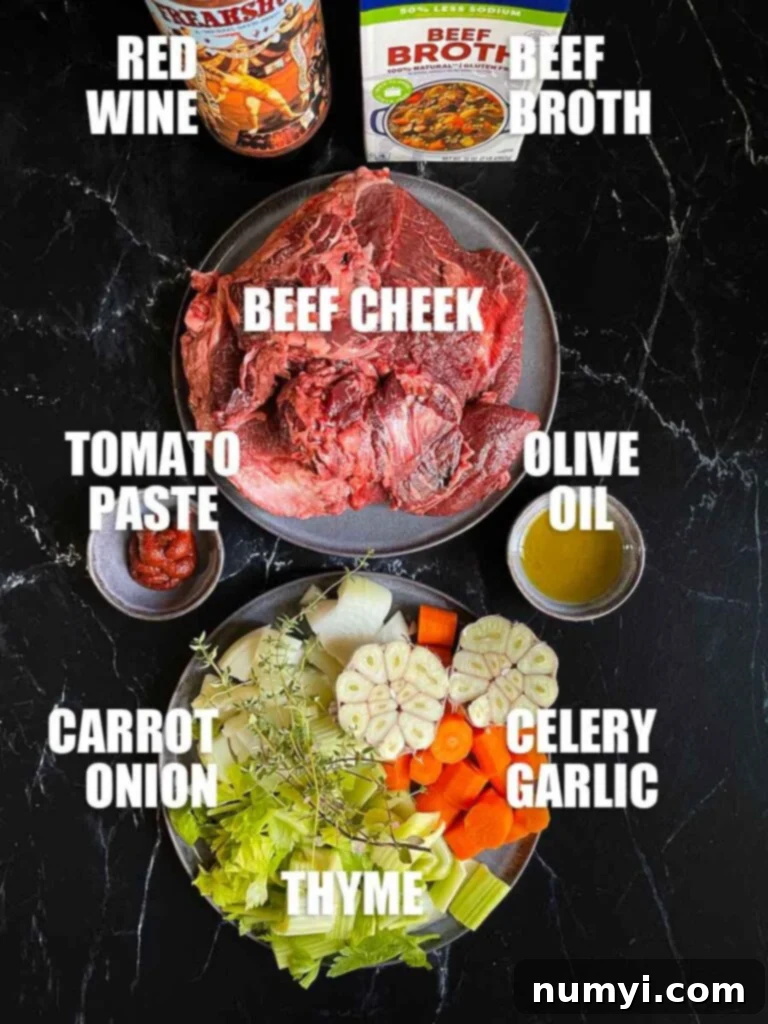
- Beef Cheeks: These are the undeniable star of our recipe. Known for their rich marbling and high collagen content, beef cheeks transform into an incredibly tender, melt-in-your-mouth experience when slow-cooked. They offer a deep, robust beefy flavor that is unmatched by many other cuts.
- Carrots, Celery, Onion (Mirepoix): This classic aromatic trio forms the foundational flavor base of our braising liquid. Carrots contribute a subtle sweetness that balances the richness of the beef, while celery adds a refreshing, slightly peppery herbal note. Onions provide a savory, pungent depth that ties all the flavors together, creating a complex and inviting aroma.
- Garlic: Halved garlic bulbs are added to infuse a distinct, pungent, and warm aroma into the dish. As they slow cook, the garlic mellows and sweetens, adding layers of savory complexity without being overpowering.
- Thyme: This earthy and slightly floral herb is a perfect complement to beef. Thyme sprigs contribute an herbaceous quality that brightens the rich, deep flavors of the braised beef cheeks, enhancing the overall aromatic profile of the dish.
- Tomato Paste: A crucial ingredient for depth, tomato paste provides concentrated umami, a touch of acidity, and a hint of sweetness. It helps to build a richer color and enhances the savory flavors of the braising liquid, making it more robust and well-rounded.
- Red Wine: Beyond adding a beautiful color, red wine brings a significant depth of flavor, complexity, and subtle fruity notes to the braising liquid. As it cooks down, the alcohol evaporates, leaving behind concentrated flavors that elevate the entire taste profile of the dish. A dry red wine like Cabernet Sauvignon or Merlot works wonderfully.
- Beef Stock: Serving as the primary liquid for braising, high-quality beef stock provides a savory, rich base that intensifies the meaty flavors of the beef cheeks. It helps create a luscious, flavorful gravy that is essential for spooning over your finished dish.
- Kosher Salt and Black Pepper: These fundamental seasonings are vital for enhancing the natural flavors of the beef and vegetables. Generous seasoning before and during the cooking process ensures a well-balanced, deeply flavored dish that isn’t bland.
These carefully selected ingredients work together in perfect harmony, each contributing its unique characteristics to create a remarkable, satisfying, and deeply flavorful dish of braised beef cheeks.
How To Make Incredibly Tender Braised Beef Cheeks
Creating perfectly braised beef cheeks is a labor of love that is incredibly rewarding. Follow these steps to achieve a truly memorable dish:
- Prepare the Beef Cheeks: Begin by carefully trimming any excess silver skin or tough connective tissue from the beef cheeks using a sharp knife. This step ensures a smoother, more palatable texture in the final dish. Once trimmed, season the beef cheeks generously on all sides with kosher salt and freshly ground black pepper. Don’t be shy with the seasoning; it forms the foundation of the dish’s flavor.
- Sear the Beef: Place a heavy-bottomed Dutch oven or a large, oven-safe pot over medium-high heat on your stovetop. Add 1 tablespoon of olive oil to the hot pot. Once the oil shimmers, carefully add the seasoned beef cheeks, working in batches if necessary to avoid overcrowding the pan. Sear the beef cheeks on all sides until they develop a deep, golden-brown crust. This crucial step, known as the Maillard reaction, locks in flavor and creates a rich, savory foundation for the braising liquid. Remove the seared beef cheeks from the pot and set them aside.
- Sauté the Aromatics: Add another tablespoon of olive oil back to the same pot. Decrease the heat to medium. Add the roughly chopped carrots, celery, and onion. Cook for about 5-7 minutes, stirring occasionally, until the vegetables begin to soften and release their aromatic compounds. This process builds another layer of flavor for the braising liquid.
- Add Garlic and Thyme: Stir in the halved garlic bulbs and fresh thyme sprigs. Continue to cook for another minute or so, until the garlic becomes fragrant. Be careful not to burn the garlic, as this can turn it bitter.
- Introduce Tomato Paste: Add the tomato paste to the vegetables. Cook for an additional minute, stirring continuously to ensure the vegetables are thoroughly coated with the paste. This step allows the tomato paste to caramelize slightly, deepening its flavor.
- Deglaze with Red Wine: Pour in the red wine. Increase the heat slightly and cook for about two minutes, scraping the bottom of the pot with a wooden spoon to release all the flavorful browned bits (fond) that have accumulated. This “deglazing” step is crucial for incorporating all those rich flavors into your sauce. Allow the wine to reduce slightly, cooking out the alcohol.
- Add Beef Stock and Simmer: Return the seared beef cheeks to the pot. Pour in the beef stock, ensuring the beef cheeks are mostly submerged in the liquid. Bring the mixture to a gentle simmer.
- Cover and Braise: For optimal results, optionally cover the surface of the liquid and beef cheeks with a cartouche (a piece of parchment paper cut to fit the pot). Then, cover the pot with its lid. Reduce the heat to low to maintain a very gentle simmer. Braise for approximately 2 to 2.5 hours, or until the beef cheeks are incredibly tender.
- Patience is Key: Braising beef cheeks is a slow art. Resist the urge to rush the cooking process. Allowing the cheeks to simmer gently on low heat for the recommended duration is paramount. This extended cooking time is what breaks down the tough connective tissues, ensuring they become incredibly tender and allows the rich, complex flavors to fully develop.
- Season Generously: Do not underestimate the importance of seasoning. Before searing, thoroughly season the beef cheeks with a good amount of kosher salt and freshly ground black pepper. The initial seasoning helps to build flavor from the inside out and creates a beautiful crust. Remember, much of the seasoning will mellow during the long cooking process, so being generous initially is vital for a well-seasoned final dish.
- Don’t Skip the Sear: Searing the beef cheeks on all sides before braising is a non-negotiable step. This process, known as the Maillard reaction, creates deep, savory flavors and a beautiful browned crust that significantly enhances the overall taste and appearance of the finished dish.
- Let it Rest and Skim the Fat: After the beef cheeks are cooked and removed from the braising liquid, allow them to rest for a few minutes before serving. This allows the meat fibers to relax and reabsorb juices, resulting in a more tender and moist product. Once you’ve strained the braising liquid, let it cool slightly. Any excess fat will rise to the surface, making it easy to skim off with a spoon or a fat separator. This step yields a cleaner, more refined, and less greasy final sauce or gravy.
- Asian-Inspired Braised Beef Cheeks: For a delightful twist, transform the flavor profile by swapping out the red wine. Instead, use a rich combination of soy sauce, mirin (sweet Japanese rice wine), and beef broth as your braising liquid. Enhance the aromatic base with ingredients like fresh ginger slices, whole star anise, and a touch of Chinese five-spice powder. Serve this version with steamed jasmine rice and a sprinkle of sesame seeds and chopped cilantro for an exotic and deeply satisfying meal.
- Spicy Braised Beef Cheeks: If you enjoy a bit of heat, infuse your braised beef cheeks with a spicy kick. Add finely diced chili peppers (like jalapeños or serranos) or red pepper flakes to the sautéing vegetables. Incorporate smoky and aromatic spices such as smoked paprika, cumin, and dried oregano into the braising liquid. Serve these fiery beef cheeks with warm corn tortillas or crusty bread. Garnish with pickled jalapeños, a dollop of cooling sour cream, and fresh cilantro for a meal that’s both bold and comforting.
- Hearty Mushroom & Herb Braised Beef Cheeks: Elevate the earthy notes by adding a generous amount of sliced cremini or wild mushrooms during the last hour of braising. Use a mix of fresh herbs like rosemary and bay leaves in addition to thyme. This variation creates an even richer, more complex sauce and adds wonderful texture.
-
Dutch Oven
-
Strainer
-
Sharp Knife
- 1 tbsp Olive oil for searing beef cheeks
- 1 tbsp Olive oil for sautéing vegetables
- 2 lbs Beef cheeks
- 2 Carrots roughly chopped
- 2 Celery stalks roughly chopped
- 1 Large onion roughly chopped
- 1 bulb Garlic halved lengthways
- 5 sprigs Fresh thyme
- 2 tbsp Tomato paste
- 1 cup Dry red wine e.g., Cabernet Sauvignon, Merlot
- 4 cups Beef stock low sodium preferred
- Kosher salt to taste
- Freshly ground black pepper to taste
-
Using a sharp knife, trim any excess silver skin or connective tissue from the beef cheeks. Season them generously on all sides with kosher salt and black pepper.Kosher salt, Black Pepper
-
Place a Dutch oven or large, heavy-bottomed pot over medium-high heat on your stovetop.
-
Add 1 tablespoon of olive oil to the hot pot.1 tbsp Olive oil
-
Once the oil is heated and shimmering, add the seasoned beef cheeks. Sear them on all sides until well-browned and a rich crust has formed. Remove the seared beef cheeks and set them aside.2 lbs Beef cheek
-
Add the remaining 1 tablespoon of olive oil back to the pot, reducing the heat to medium.1 tbsp Olive oil
-
Add the roughly chopped carrots, celery, and onion to the Dutch oven. Cook for approximately 5 minutes, stirring occasionally, until the vegetables begin to soften.2 Carrots, 2 Celery, 1 Onion
-
Add the halved garlic bulb and fresh thyme sprigs to the vegetables. Continue to cook for about a minute, stirring, until the garlic becomes fragrant.1 bulb Garlic, 5 sprigs Thyme
-
Stir in the tomato paste and cook for an additional minute, ensuring the vegetables are well-coated and the paste begins to caramelize.2 tbsp Tomato paste
-
Pour in the red wine. Increase the heat slightly and cook for about two minutes, scraping the browned bits from the bottom of the pot with a wooden spoon. This deglazing step adds immense flavor. Allow the alcohol to cook out.1 cup Red wine
-
Add the beef stock to the pot and return the seared beef cheeks. Reduce the heat to a gentle simmer.4 cups Beef stock
-
Optionally, cover the surface of the liquid with a cartouche (parchment paper cut to fit) and then cover the pot with its lid. Simmer gently for approximately 2 to 2.5 hours on low heat.
-
The beef cheeks are done when they are incredibly tender and can be easily torn apart with a spoon.
-
Carefully remove the tender beef cheeks from the pot and set them aside.
-
Strain the remaining braising liquid through a fine-mesh sieve into a clean saucepan, discarding the cooked vegetables. You can reduce this liquid further to thicken it into a gravy if desired.
-
Serve the braised beef cheeks on a plate or in a shallow bowl, spooning the rich gravy over them. Garnish with chopped parsley or green onion, and serve with your favorite complementary sides like creamy polenta or mashed potatoes.
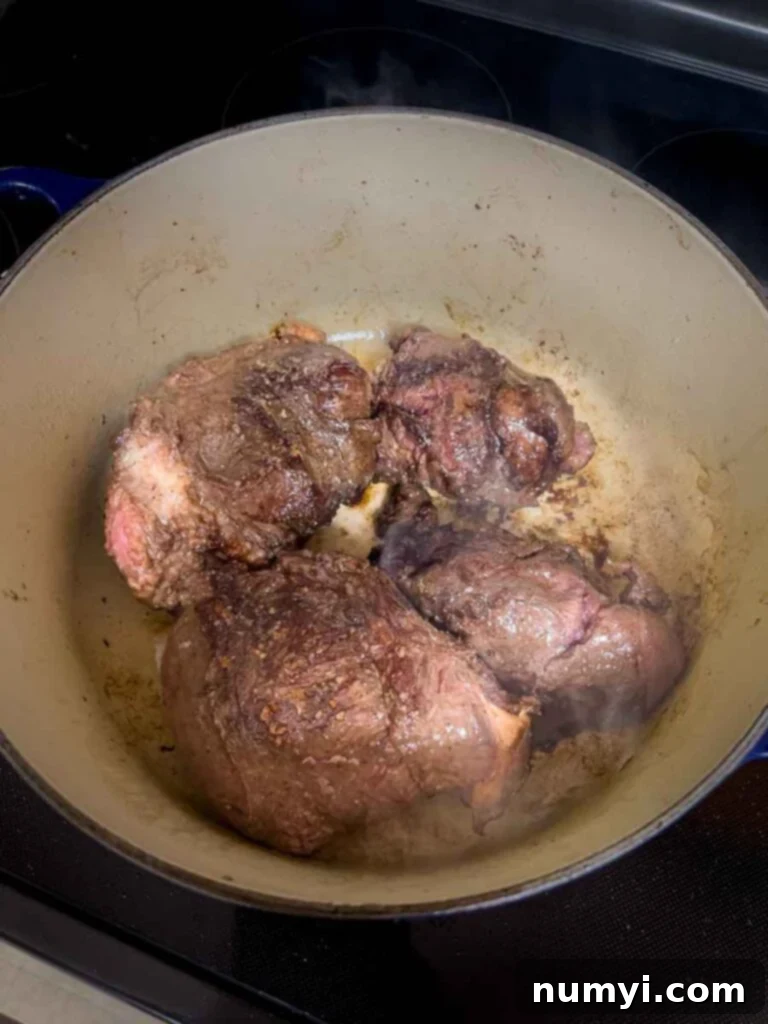
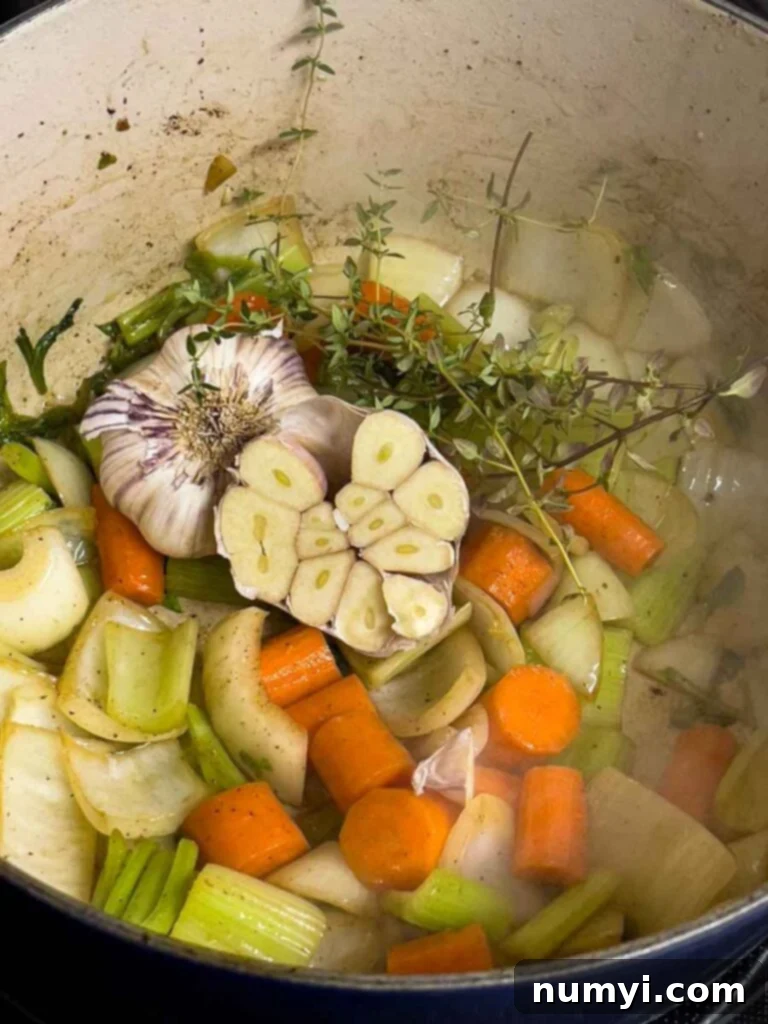

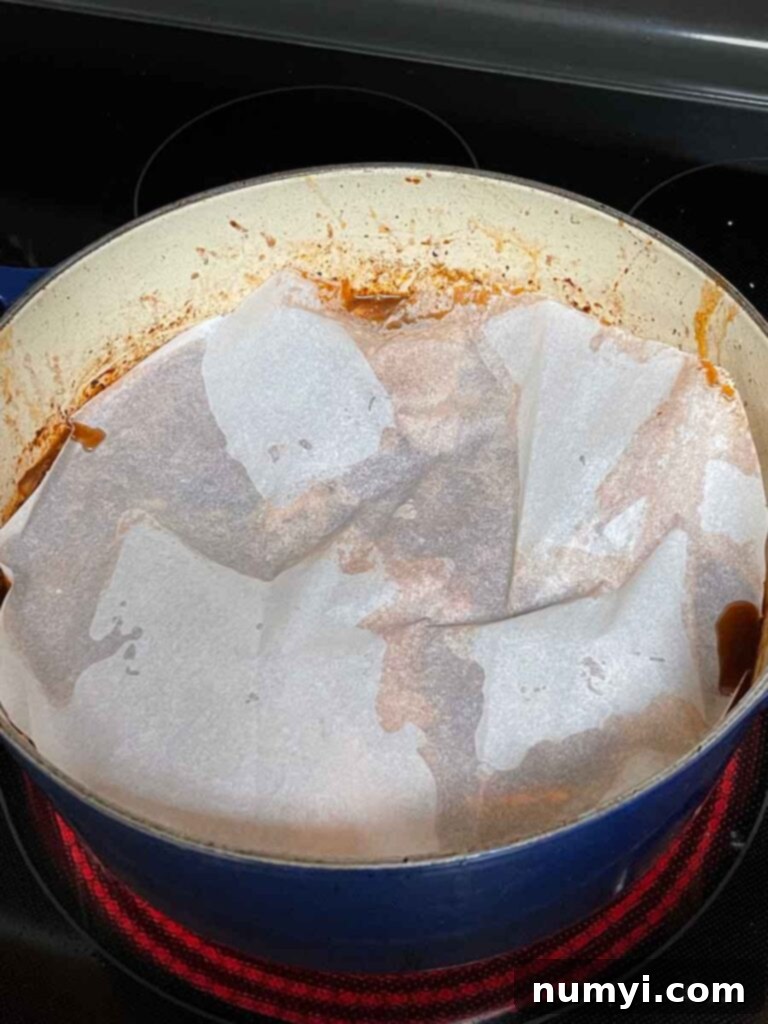
pro tip
A cartouche is a simple but remarkably effective cooking technique often employed to cover the surface of a dish during slow cooking or braising. In the context of braised beef cheeks, a cartouche serves several important purposes that contribute to the dish’s overall success:
Placing a cartouche directly on the surface of the braising liquid helps significantly minimize evaporation during the prolonged slow-cooking process. This critical step ensures that moisture is retained within the dish, preventing the beef from drying out and ensuring a consistently juicy and tender result.
The cartouche acts as a barrier, helping to distribute heat more evenly across the entire surface of the braising liquid and, consequently, the beef cheeks. This promotes more consistent cooking, ensuring that all pieces of meat are tenderized uniformly and that the rich flavors infuse thoroughly throughout the dish.
By effectively reducing the evaporation of the braising liquid, the cartouche allows the flavors within the pot to become more concentrated over time. It traps steam and condensation, which then drips back into the liquid, contributing to a richer, more intense, and deeply savory sauce as the dish slowly cooks.
The combined use of a cartouche and the pot’s lid creates a gentle, controlled, and consistently moist cooking environment. This slow and steady cooking process is crucial for breaking down the tough collagen and connective tissues found in beef cheeks, ultimately resulting in an exquisitely tender and succulent final texture that truly falls apart at the slightest touch.
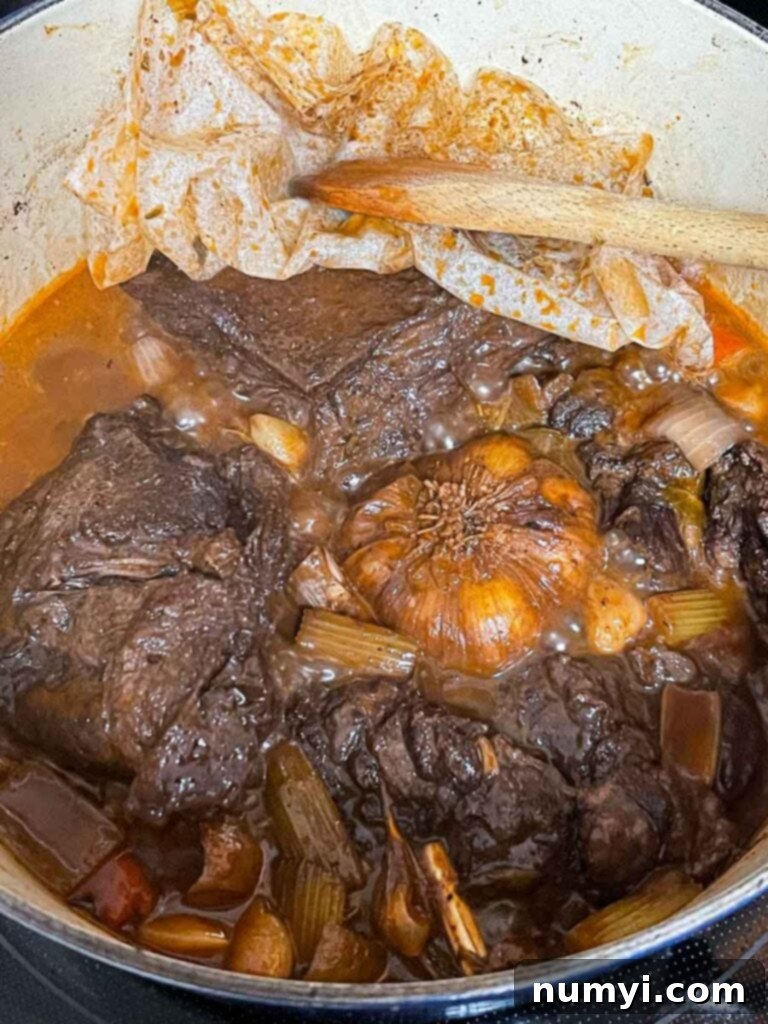
The beef cheeks are done when they are incredibly tender and yield easily to a spoon. This typically takes about 2 to 2.5 hours, but may vary depending on your specific cut and cooking vessel. Patience is key here; don’t rush the process.
Once the beef cheeks have reached their peak tenderness, carefully remove them from the pot and set them aside. They will be delicate, so handle them gently.
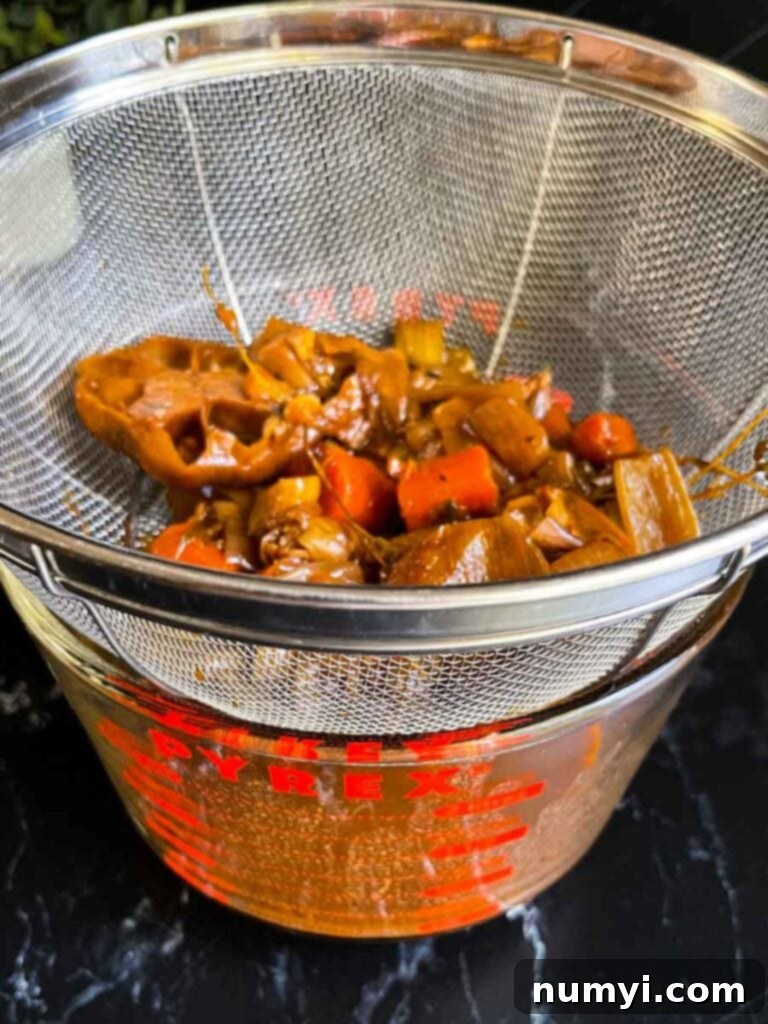
Strain the remaining braising liquid through a fine-mesh sieve into a clean saucepan or bowl, discarding the cooked vegetables. These vegetables have given all their flavor to the sauce, so we only need the rich liquid. If desired, you can reduce the strained liquid over medium-high heat until it thickens slightly to create a more concentrated gravy. Taste and adjust seasoning as needed.
Serve and Enjoy: Serve the magnificent braised beef cheeks on a plate or in a shallow bowl, spooning a generous amount of the rich gravy over them. For a fresh touch and visual appeal, optionally garnish with some finely chopped fresh parsley or green onion. These herbs add a vibrant contrast and a hint of freshness.
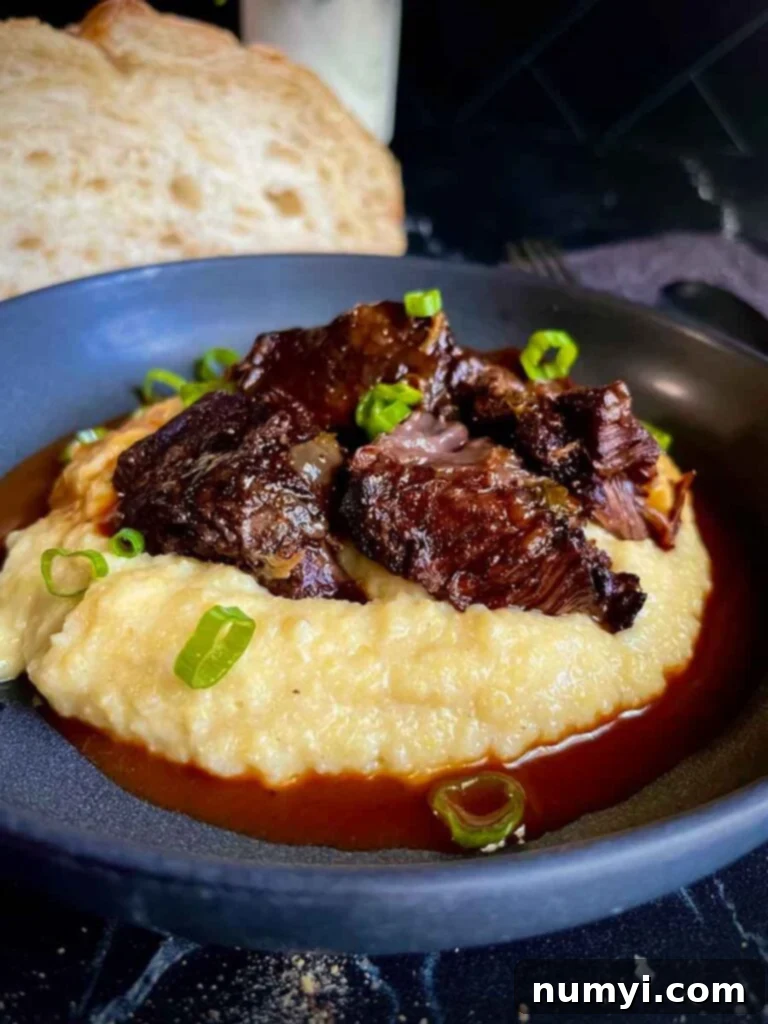
Pair this luxurious dish with your favorite sides. As mentioned, our creamy polenta is an absolute must-try accompaniment, offering a smooth counterpoint to the rich beef. Decadent mashed potatoes are also a perfect match for this comforting meal. Enjoy the succulent, flavorful experience!
Tips For Success and Exciting Variations
To ensure your braised beef cheeks are nothing short of spectacular, keep these tips in mind and consider these delicious variations:
Essential Tips for Perfect Braised Beef Cheeks:
Creative Variations for Braised Beef Cheeks:
Frequently Asked Questions (FAQs) About Beef Cheeks
Beef cheeks are a distinctive and flavorful cut of meat sourced from the facial muscles of a cow. These muscles are heavily worked, making them inherently tough. However, this toughness is precisely why they are ideally suited for slow-cooking methods. Despite being a relatively inexpensive cut, beef cheeks are highly prized by chefs and home cooks alike for their remarkable marbling, intensely deep beefy flavor, and the luxurious, melt-in-your-mouth texture they develop when properly braised or slow-cooked. The high collagen content breaks down beautifully, creating a rich, gelatinous mouthfeel.
In the United States, this specific cut is most commonly referred to simply as “beef cheeks.” However, you might occasionally encounter them labeled as “beef jowl” or sometimes just “cheeks” in some specialty butcher shops, high-end restaurants, or certain culinary contexts. It’s always a good idea to confirm with your butcher if you’re unsure, as regional terminology can sometimes vary slightly.
Absolutely, beef cheek meat is highly regarded and considered an exceptionally delicious and flavorful cut. While it might not be as widely consumed or as familiar as more common cuts of beef, beef cheeks offer a truly unique and enjoyable culinary experience. When prepared correctly, particularly through slow braising, beef cheeks become incredibly tender, rich, and succulent. They are celebrated for their substantial collagen content, which transforms during the cooking process into gelatin, contributing to that highly desirable melt-in-your-mouth texture and adding incredible body to sauces.
No, beef cheek is generally considered to be an inexpensive and economical cut of meat. It falls into the category of “less popular” or “underutilized” cuts, which often contributes to its lower price point when compared to more mainstream and in-demand cuts like prime steaks or large roasts. Despite its affordability, beef cheeks are highly valued by experienced chefs and food enthusiasts for their rich flavor, profound tenderness, and gelatinous texture once cooked properly. They do require slow cooking methods, such as braising, to unlock their full potential and transform them into a truly delectable and tender dish. Therefore, while beef cheeks are more affordable, they offer exceptional taste and culinary versatility, making them a fantastic choice for preparing flavorful and comforting meals that feel luxurious without the high cost.
Without a doubt, the best way to prepare beef cheeks is through braising. Braising is a classic cooking technique that involves first searing the meat to develop a flavorful crust, then slow-cooking it submerged in a rich, aromatic liquid (such as wine, broth, or a combination) at a low temperature for an extended period. This method is perfectly suited for beef cheeks because it allows the tough connective tissues and collagen to gradually break down and convert into gelatin. This transformation results in meat that is incredibly tender, moist, and succulent, creating a luscious sauce in the process. Other slow-cooking methods like stewing or cooking in a slow cooker can also yield excellent results, but braising is generally considered superior for its ability to build complex flavors.
Yes, beef cheek absolutely possesses a distinct and unique taste compared to many other cuts of beef. Because the cheek muscles are well-exercised, they develop an exceptionally rich, deep, and intensely beefy flavor. This flavor is more concentrated and robust than what you might find in a tenderloin or sirloin. Beef cheek also has a unique combination of this deep flavor with a luxurious, melt-in-your-mouth consistency that truly sets it apart. Its abundant marbling and high connective tissue content contribute significantly to its inherent richness and an almost sticky, gelatinous mouthfeel when slow-cooked. Overall, beef cheek offers a singular and wonderfully delicious culinary experience for those who appreciate its distinctive taste and remarkable texture.
Other Delicious Slow-Cooked Dishes to Explore
If you’ve fallen in love with the magic of slow cooking after trying our braised beef cheeks, there are many other incredible recipes that utilize this patient and rewarding technique. Here are a few to inspire your next comforting meal:
Slow Cooker Beef Stew
Slow Cooker Roasted Chicken
Slow Cooker Corned Beef
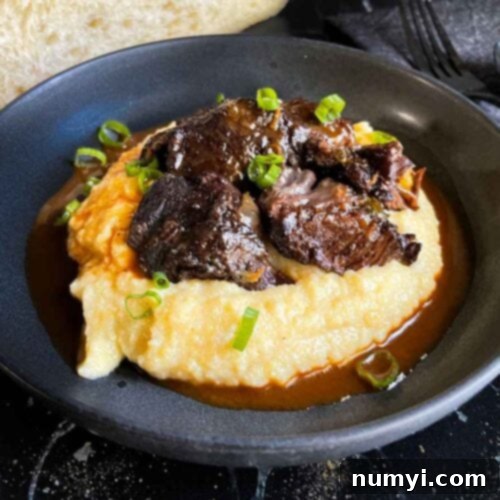
Braised Beef Cheeks
Print
Pin
Rate
Equipment
Ingredients
Instructions
Notes
Cool the leftovers: It’s essential to allow the braised beef cheeks and their accompanying gravy to cool down completely to room temperature before storing. This crucial step helps prevent the growth of harmful bacteria and ensures the quality and safety of the meat are maintained.
Store in airtight containers: Once cooled, transfer the beef cheeks and all of the delicious gravy or sauce into airtight containers. Make sure to leave a little space at the top of the container, especially if you plan to freeze, to allow for any expansion.
Refrigeration: If you intend to enjoy your leftovers within a few days, store them in the refrigerator. Braised beef cheeks can typically be safely refrigerated for up to 3-4 days, making them perfect for meal prepping.
Freezing: For longer-term storage, braised beef cheeks freeze exceptionally well. Place them in a freezer-safe container or robust freezer bags, ensuring as much air as possible is removed to prevent freezer burn. Label the containers clearly with the date for easy reference. When properly stored, they can be kept in the freezer for up to 3 months without significant loss of quality.
Thawing and reheating: When you’re ready to enjoy your frozen leftovers, thaw them overnight in the refrigerator. Once fully thawed, you can gently reheat the beef cheeks on the stovetop in a saucepan over low heat. Alternatively, you can reheat them in the oven at a low temperature (around 300°F or 150°C) until heated through. If the sauce appears too thick, add a splash of beef broth or water to achieve the desired consistency. Stir occasionally to ensure even heating and prevent drying out.
